heater Oldsmobile Achieva 1998 Owner's Manuals
[x] Cancel search | Manufacturer: OLDSMOBILE, Model Year: 1998, Model line: Achieva, Model: Oldsmobile Achieva 1998Pages: 356, PDF Size: 18.04 MB
Page 65 of 356
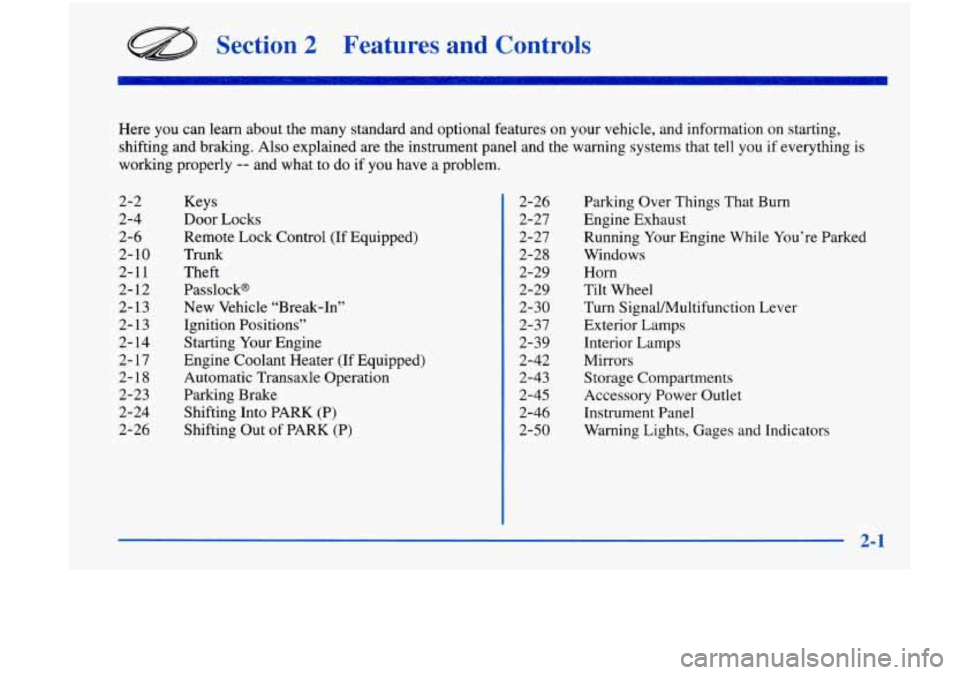
Section 2 2s and COI :- 11s
Here you can learn about the many standard and optional features on your vehicle, and information on starting,
shifting and braking. Also explained
are the instrument panel and the warning systems that tell you if everything is
working properly
-- and what to do if you have a problem.
2-2
2-4
2-6 2-10
2-11
2- 12
2-13
2-13
2- 14
2-
17
2-18
2-23
2-24 2-26 Keys
Door Locks
Remote
Lock Control
(If Equipped)
Trunk
Theft
Passlock@
New Vehicle “Break-In”
Ignition Positions”
Starting Your Engine
Engine Coolant Heater (If Equipped)
Automatic Transaxle Operation
Parking Brake
Shifting Into PARK (P)
Shifting Out of PARK (P) 2-26
2-27
2-27
2-28
2-29 2-29
2-30
2-37
2-39
2-42
2-43 2-45
2-46
2-50 Parking Over
Things That
Burn
Engine Exhaust
Running Your Engine While You’re Parked
Windows
Horn
Tilt Wheel
Turn Signal/Multifunction Lever
Exterior Lamps
Interior Lamps
Mirrors Storage Compartments
Accessory Power Outlet
Instrument Panel
Warning Lights, Gages and Indicators
2-1
Page 81 of 356
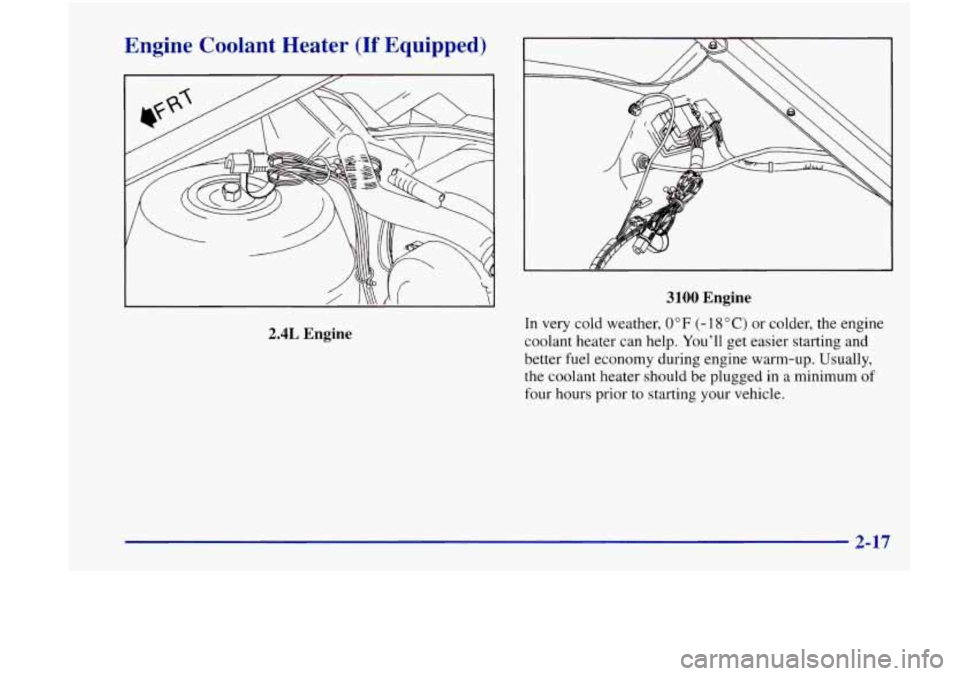
Engine Coolant Heater (If Equipped)
2.4L Engine
3100 Engine
In very cold weather, 0°F (- 1 8 O C) or colder, the engine
coolant heater can help. You’ll get easier starting and
better fuel economy during engine warm-up. Usually,
the coolant heater should be plugged in a minimum
of
four hours prior to starting your vehicle.
Page 82 of 356
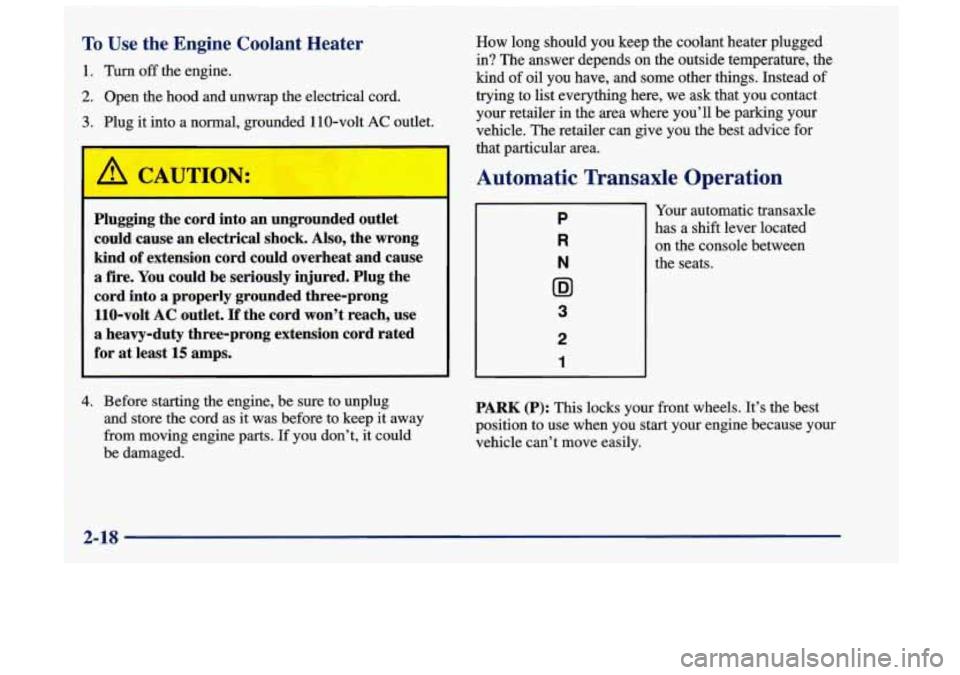
! To Use the Engine Coolant Heater
1. Turn off the engine.
1 2. Open the hood and unwrap the electrical cord.
3. Plug it into a normal, grounded 11 0-volt AC oatlet.
Plugging the cord into an ungrounded outlet
could cause an electrical shock. Also, the wrong
kind of extension cord could overheat and cause
a fire. You could be seriously injured. Plug the
cord
into a properly grounded three-prong
110-volt
AC outlet. If the cord won’t reach, use
a heavy-duty three-prong extension cord rated
for
at least 15 amps.
I
How long should you keep the coolant heater plugged
in? The answer depends on the outside temperature, the
kind of oil you have, and some other things. Instead of
trying to list.everyhng here, we ask that you contact
your retailer in the area where you’ll be parking your
vehicle. The retailer can give you the best advice for
that particular area.
Automatic Transaxle Operation
P
R
N
ID1
3
2
1
Your automatic transaxle
has a
shift lever located
on the console between
the seats.
4. Before starting the engine, be sure to unplug
and store the cord as it was before to keep it away
from moving engine parts.
If you don’t, it could
be damaged.
PARK (P): This locks your front wheels. It’s the best
position
to use when you start your engine because your
vehicle can’t move easily.
2-18
Page 127 of 356
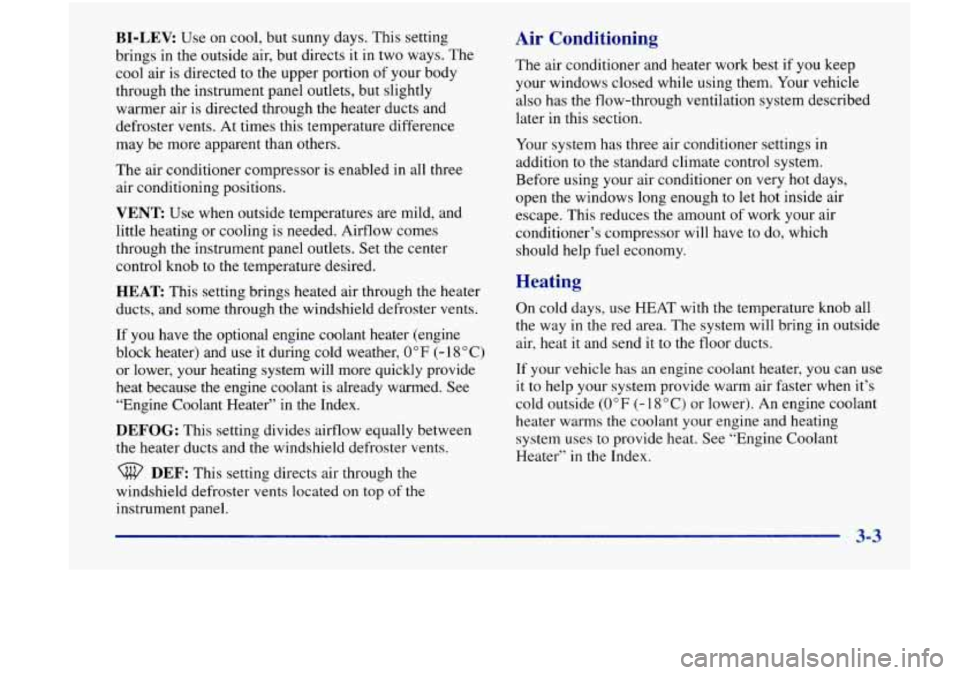
BI-LEV: Use on cool, but sunny days. This setting
brings in the outside air, but directs it in two ways. The
cool air is directed to the upper portion of your body
through the instrument panel outlets, but slightly
warmer air is directed through the heater ducts and
defroster vents. At times this temperature difference
may be more apparent than others.
The air conditioner compressor is enabled in all three
air conditioning positions.
VENT: Use when outside temperatures are mild, and
little heating or cooling is needed. Airflow comes
through the instrument panel outlets. Set the center
control knob to the temperature desired.
HEAT This setting brings heated air through the heater
ducts, and some through the windshield defroster vents.
If you have the optional engine coolant heater (engine
block heater) and use it during cold weather,
0 “F (- 18 O C)
or lower, your heating system will more quickly provide
heat because the engine coolant
is already warmed. See
“Engine Coolant Heater” in the Index.
DEFOG: This setting divides airflow equally between
the heater ducts and the windshield defroster vents.
DEF: This setting directs air through the
windshield defroster vents located
on top of the
instrument panel.
Air Conditioning
The air conditioner and heater work best if you keep
your windows closed while using them. Your vehicle
also has the flow-through ventilation system described
later
in this section.
Your system has three air conditioner settings in
addition to the standard climate control system.
Before using your air conditioner
on very hot days,
open the windows long enough to let hot inside air
escape. This reduces the amount of work your air
conditioner’s compressor will have to do, which
should help fuel economy.
Heating
On cold days, use HEAT with the temperature knob all
the way in the red area. The system will bring in outside
air, heat it and send it to the floor ducts.
If your vehicle has an engine coolant heater, you can use
it to help your system provide warm air faster when it’s
cold outside
(0°F (-18°C) or lower). An engine coolant
heater warms the coolant your engine and heating
system
uses to provide heat. See “Engine Coolant
Heater”
in the Index.
Page 130 of 356
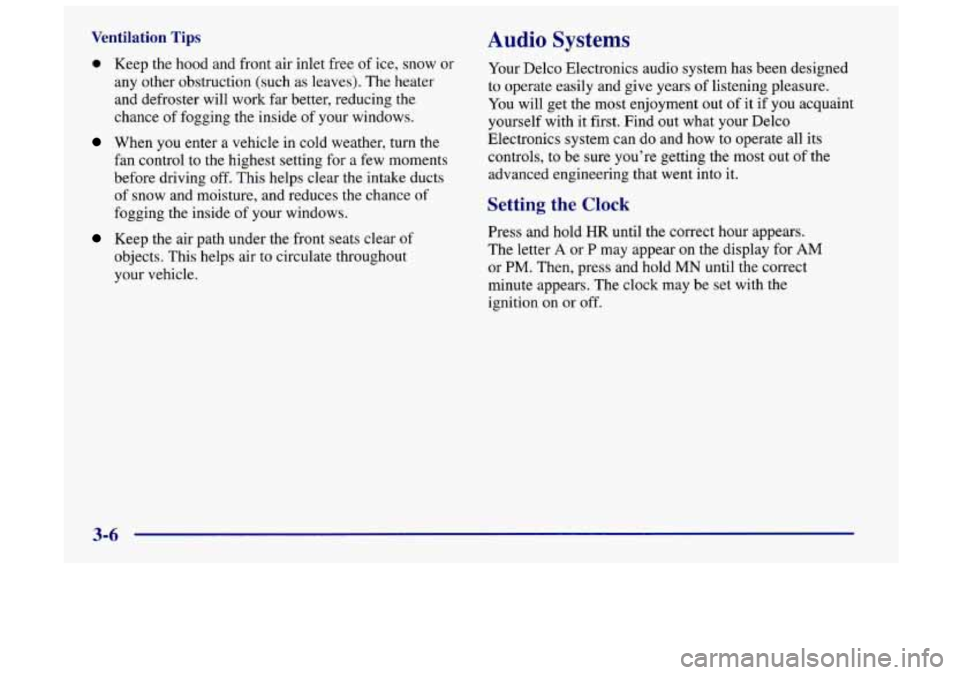
Ventilation Tips Audio Systems
0 Keep the hood and front air inlet free of ice, snow or
any other obstruction (such as leaves). The heater
and defroster will work far better, reducing the
chance of fogging the inside of your windows.
When you enter a vehicle in cold weather, turn the
fan control to the highest setting for a few moments
before driving off. This helps clear the intake ducts
of snow and moisture, and reduces the chance
of
fogging the inside of your windows.
Keep the air path under the front seats clear of
objects. This helps air to circulate throughout
your vehicle. Your
Delco Electronics audio system has been designed
to operate easily and give years
of listening pleasure.
You will get the most enjoyment out
of it if you acquaint
yourself with it first. Find out what your Delco
Electronics system can do and how to operate all its
controls, to be sure you’re getting the most out of the
advanced engineering that went into it.
Setting the Clock
Press and hold HR until the correct hour appears.
The letter
A or P may appear on the display for AM
or PM. Then, press and hold MN until the correct
minute appears. The clock may be set with the
ignition on
or off.
3-6
Page 177 of 356
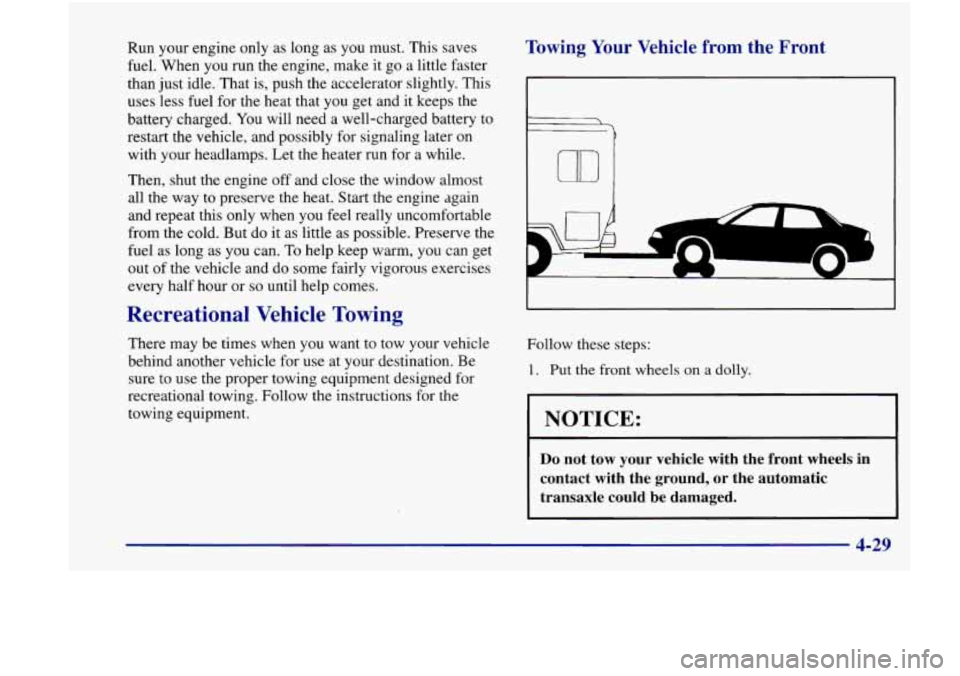
Run your engine only as long as you must. This saves
fuel. When you run the engine, make it go a little faster
than just idle. That is, push the accelerator slightly. This
uses less fuel for the heat that you get and
it keeps the
battery charged. You will need
a well-charged battery to
restart the vehicle, and possibly for signaling later on
with your headlamps. Let the heater run for a while.
Then, shut the engine off and close the window almost
all the way to preserve the heat. Start the engine again
and repeat this only when you
feel really uncomfortable
from the cold. But do it as little as possible. Preserve the
fuel as long as you can.
To help keep warm, you can get
out of the vehicle and do some fairly vigorous exercises
every half hour or
so until help comes.
Recreational Vehicle Towing
There may be times when you want to tow your vehicle
behind another vehicle for use at your destination. Be sure
to use the proper towing equipment designed for
recreational towing. Follow the instructions for the
towing equipment.
Towing Your Vehicle from the Front
Follow these steps:
1. Put the front wheels on a dolly.
NOTICE:
Do not tow your vehicle with the front wheels in
contact with the ground, or the automatic
transaxle could be damaged.
4-29
Page 204 of 356

If No Steam Is Coming From Your Engine
If you get the overheat warning but see or hear no
steam, the problem may not be too serious. Sometimes
the engine can get a little too hot when you:
Climb a long hill on a hot day.
Stop after high-speed driving.
Idle for long periods in traffic.
Tow a trailer.
If you get the overheat warning with no sign of steam,
try this for a minute or
so:
1. Turn off your air conditioner.
2. Turn on your heater to full hot at the highest fan
speed and open the window as necessary.
3. If you’re in a traffic jam, shift to NEUTRAL (N);
otherwise, shift to the highest gear while
driving
-- AUTOMATIC OVERDRIVE (@)
or DRIVE (D).
If you no longer have the overheat warning, you can
drive. Just to be safe, drive slower for about
10 minutes.
If the warning doesn’t come back on, you can
drive normally.
If the warning continues, pull over,
stop, and park your
vehicle right away.
If there’s still no sign of steam, you can idle the engine
for two or three minutes while you’re parked, to see if
the warning stops. But then, if you still have the
warning, turn oathe engine
and get everyone out of the
vehicle until it cools down.
You may decide not to lift the hood but to get service
help right away.
5-16
Page 206 of 356
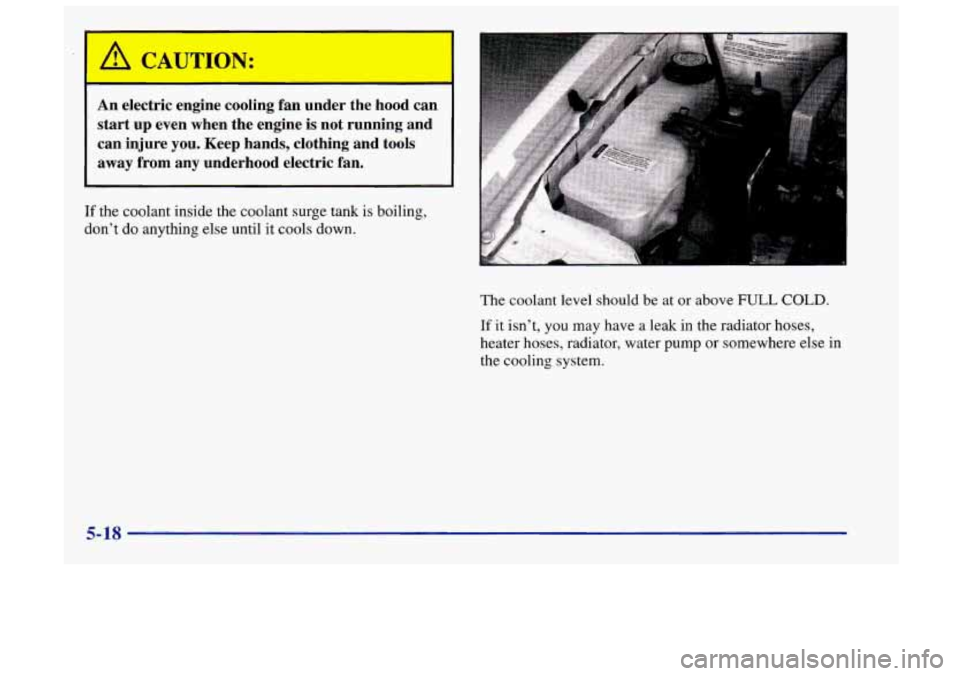
I
L AUTION
-
An electric engine cooling fan under the hood can
start up even when the engine is not running and
can injure you. Keep hands, clothing and tools
away from any underhood electric fan.
If the coolant inside the coolant surge tank is boiling,
don’t do anything else until it cools down.
The coolant level should be at or above FULL COLD.
If it isn’t, you may have a leak in the radiator hoses,
heater hoses, radiator, water pump
or somewhere else in
the cooling system.
5-18
Page 207 of 356
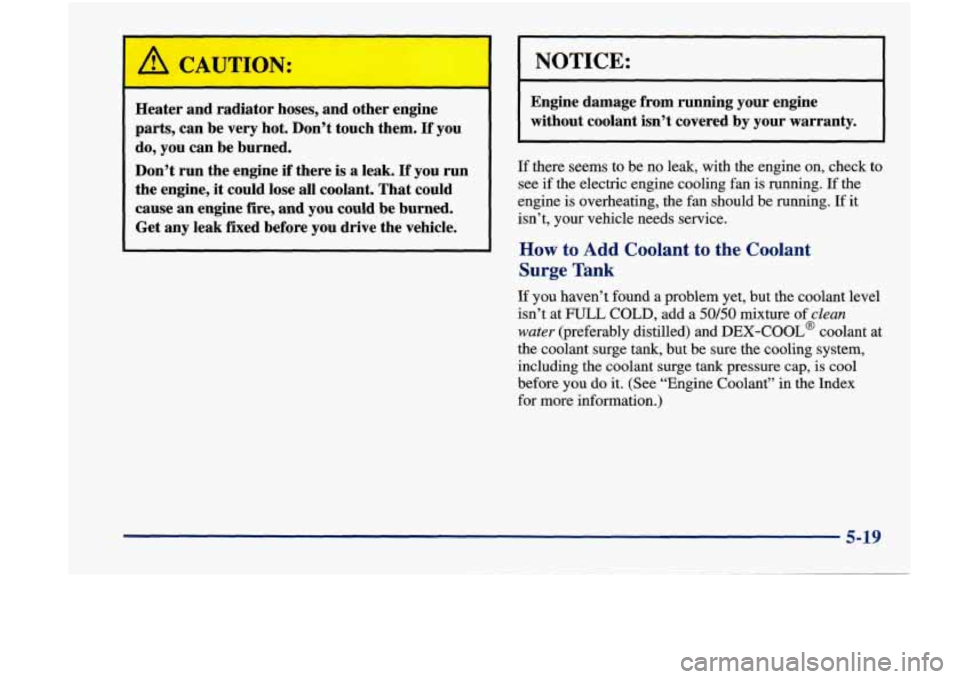
, ,- CAUTION:
~ Heater and radiator hoses, and other engine
1 parts, can be very hot. Don’t touch them. If you
l do, you can be burned.
Don’t run the engine
if there is a leak. If you run
1 the engine, it could lose all coolant. That could
cause an engine
fire, and you could be burned.
’ Get any leak fixed before you drive the vehicle.
NOTICE:
Engine damage from running your engine
without coolant isn’t covered by your warranty.
.
If there seems to be no leak, with the engine on, check to
see if the electric engine cooling fan is running.
If the
engine is overheating, the fan should be running.
If it
isn’t, your vehicle needs service.
How to Add Coolant to the Coolant
Surge Tank
If you haven’t found a problem yet, but the coolant level
isn’t at
FULL COLD, add a 50/50 mixture of clean
water (preferably distilled) and DEX-COOL@ coolant at
the coolant surge tank, but be sure the cooling system,
including the coolant surge
tank pressure cap, is cool
before you do it. (See “Engine Coolant” in the Index
for more information.)
5-19
Page 209 of 356
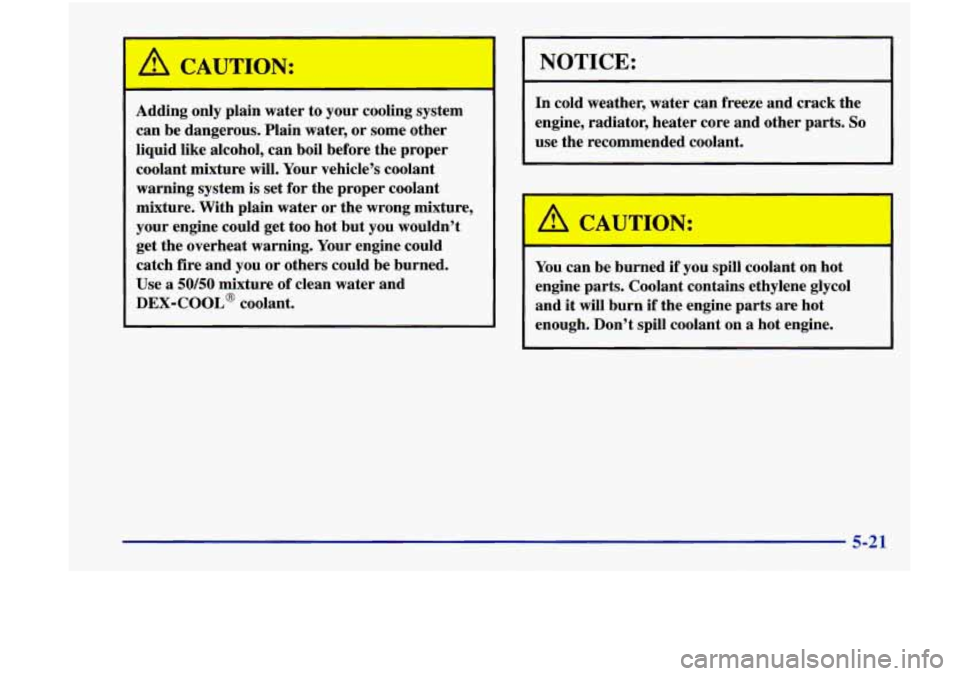
A CAUTION:
Adding only plain water to your cooling system
can be dangerous. Plain
water, or some other
liquid like alcohol, can boil before the proper
coolant mixture will. Your vehicle’s coolant
warning system is set for the proper coolant
mixture. With plain water or the wrong mixture,
your engine could get too hot but you wouldn’t
get the overheat warning. Your engine could
catch fire and you or others could be burned.
Use
a 50/50 mixture of clean water and
DEX-COOL@ coolant.
I NOTICE:
In cold weather, water can freeze and crack the
engine, radiator, heater core and other parts.
So
use the recommended coolant.
A CAUTION:
~
You can be burned if you spill coolant on hot
engine parts. Coolant contains ethylene glycol
and it will burn
if the engine parts are hot
enough. Don’t spill coolant on a hot engine.
5-21